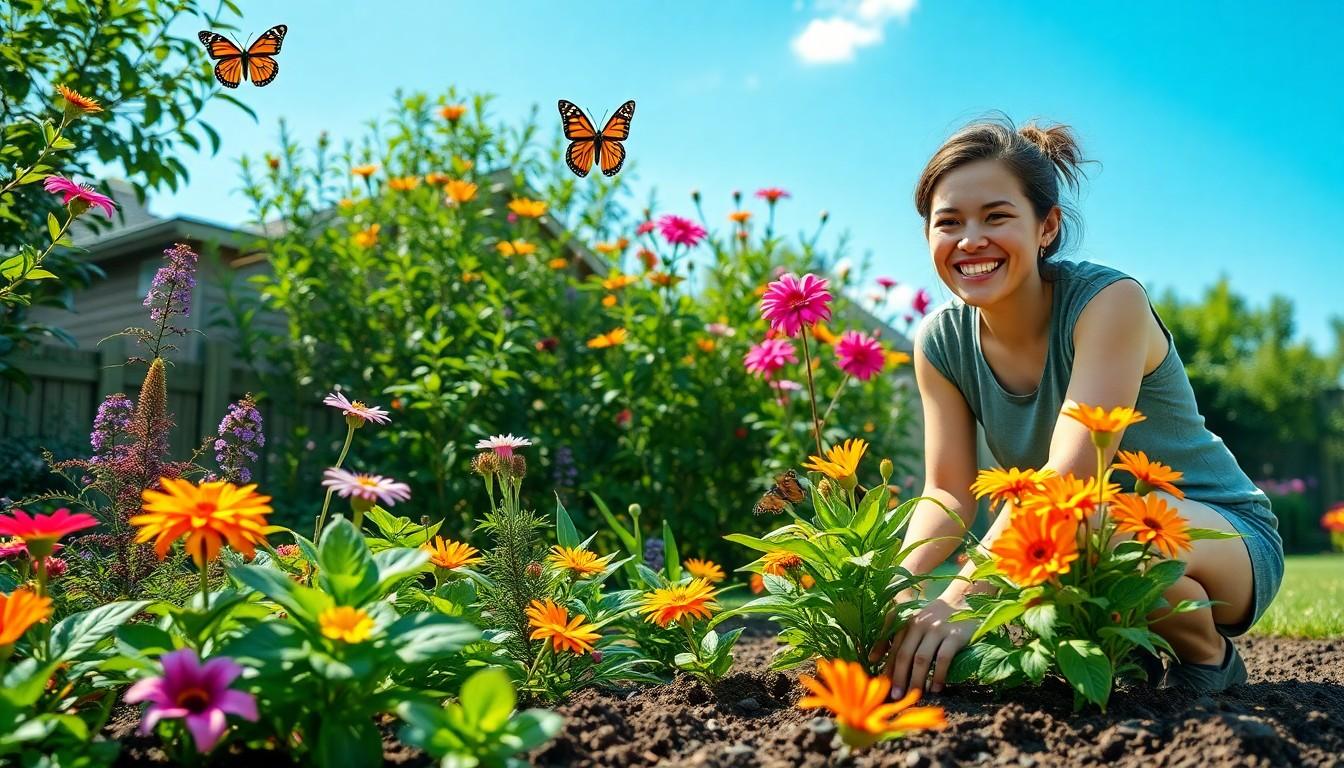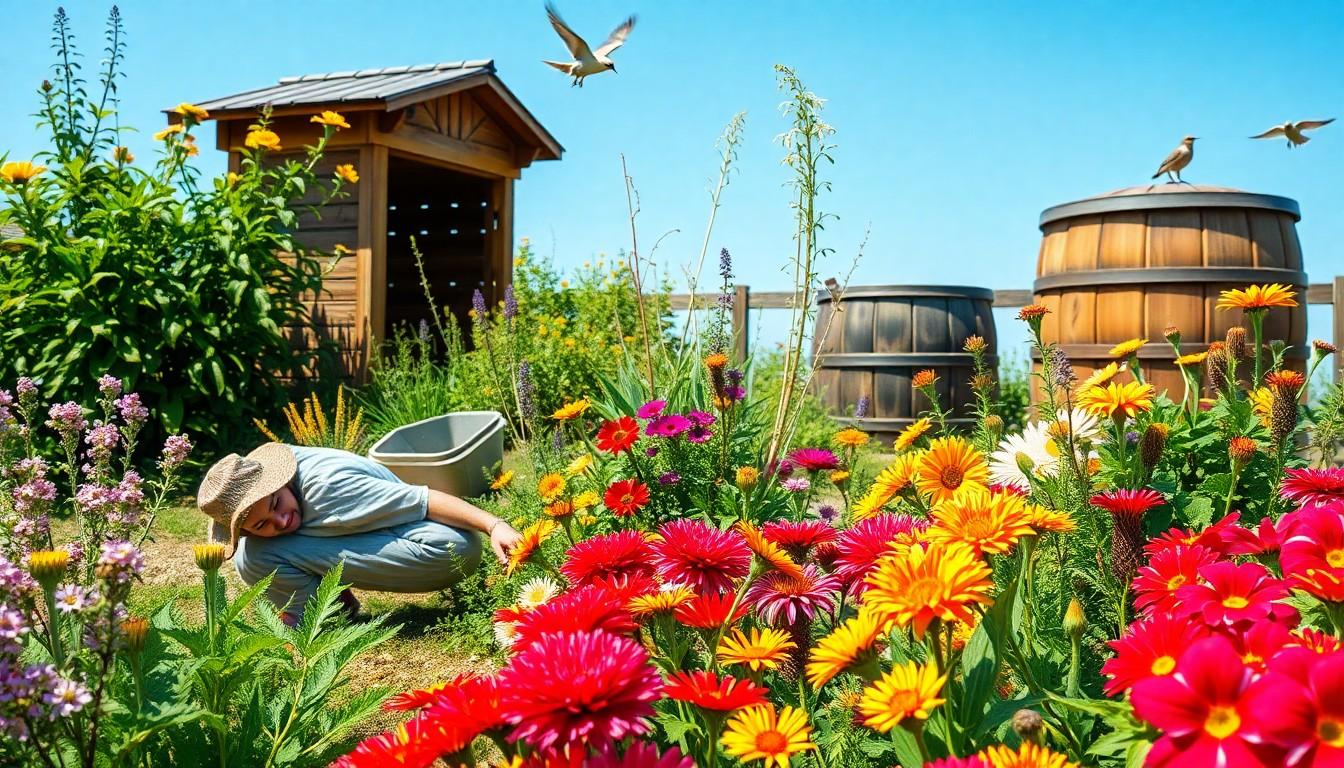Imagine a yard that not only looks stunning but also gives Mother Nature a high-five. Eco-friendly landscaping is the superhero of outdoor design, transforming mundane patches of grass into vibrant ecosystems that thrive without the guilt of harming the planet. It’s like throwing a party for your garden, where native plants, sustainable materials, and smart water practices are the guests of honor.
Eco-Friendly Landscaping
Eco-friendly landscaping encompasses practices that promote sustainability and resource conservation. It fosters biodiversity while enhancing the beauty of outdoor spaces.
Definition and Importance
Eco-friendly landscaping refers to designing and maintaining gardens and yards with a focus on environmental health. This approach significantly reduces chemical usage, conserving soil integrity and improving air quality. By incorporating native plants and organic materials, eco-friendly landscaping contributes to habitat preservation. Furthermore, it supports local wildlife and promotes pollinator diversity, which is crucial for maintaining ecosystems. Prioritizing sustainability fosters community awareness, encouraging others to adopt environmentally responsible landscaping practices. Implementing these principles not only benefits individual properties but also enhances the overall health of the environment.
Key Principles
Key principles of eco-friendly landscaping guide its implementation. First, utilizing native plants minimizes water usage since these plants are adapted to the local climate. Second, incorporating sustainable materials reduces environmental impact through recycling and repurposing. Third, practicing efficient water management techniques, like drip irrigation, conserves water resources. Additionally, composting organic waste enriches soil naturally, minimizing reliance on chemical fertilizers. Promoting biodiversity through the establishment of varied plant species supports ecosystem resilience. Maintaining a healthy garden through integrated pest management also reduces reliance on harmful pesticides. These principles collectively create a sustainable and vibrant landscape that benefits both the environment and the community.
Benefits of Eco-Friendly Landscaping
Eco-friendly landscaping offers numerous advantages that enhance both individual properties and the surrounding environment. These benefits include positive environmental impact, aesthetic advantages, and long-term cost savings.
Environmental Impact
Eco-friendly landscaping significantly reduces environmental degradation. Implementing native plants leads to lower water consumption, promoting conservation. The reduction of harmful chemicals contributes to improved soil health and air quality. Wildlife thrives in these landscapes, fostering biodiversity. Pollinator-friendly plants attract bees and butterflies, supporting critical ecosystems.
Aesthetic Advantages
Aesthetic appeal thrives in eco-friendly landscapes. Native plants provide vibrant colors and diverse textures, enhancing visual interest. These landscapes create a sense of harmony with the environment, evoking a natural beauty. Well-designed eco-friendly gardens invite relaxation and connection with nature. The integration of sustainable materials offers unique design opportunities, allowing for creativity while remaining environmentally conscious.
Cost Savings Over Time
Cost savings accumulate through eco-friendly landscaping practices. Reduced water usage translates into lower utility bills. Native plants require less maintenance, minimizing gardening expenses. Long-term investment in sustainable materials tends to yield durability, reducing replacement costs. Composting organic waste creates nutrient-rich soil, lessening the need for chemical fertilizers. Over time, the overall financial benefits of eco-friendly landscaping become substantial.
Essential Elements of Eco-Friendly Landscaping
Eco-friendly landscaping incorporates various essential elements that promote sustainability. Three key components include the use of native plants, water conservation techniques, and sustainable materials.
Native Plants
Native plants thrive in local climates and ecosystems, requiring less water and maintenance. These plants support local wildlife and attract beneficial pollinators such as bees and butterflies. Opting for native species fosters biodiversity, which enriches the garden’s ecosystem. This choice not only enhances aesthetics but also helps preserve regional character. Choosing plants native to the area significantly lowers the need for chemical fertilizers and pesticides.
Water Conservation Techniques
Effective water conservation techniques help maintain lush landscapes with minimal runoff. Drip irrigation systems deliver water directly to plant roots, ensuring efficient usage. Rain barrels collect rainwater, offering a sustainable solution for irrigation needs. Additionally, xeriscaping promotes the use of drought-tolerant plants designed to thrive in arid conditions. These techniques reduce reliance on municipal water supplies, conserving both water and money.
Sustainable Materials
Utilizing sustainable materials reduces environmental impact while enhancing landscape durability. Recycled materials, such as reclaimed wood, provide attractive and eco-friendly options for garden structures. Organic mulch helps retain soil moisture, suppresses weeds, and improves soil health. Certified green products, including non-toxic fertilizers and pest control solutions, contribute to environmentally responsible gardening. Choosing sustainable materials ensures a balance between aesthetic appeal and ecological responsibility.
Popular Eco-Friendly Landscaping Practices
Eco-friendly landscaping encompasses various practices that promote sustainability and resource conservation. These methods enhance outdoor spaces while benefiting the environment.
Xeriscaping
Xeriscaping focuses on reducing water use, ideal for regions with limited rainfall. Native plants play a crucial role in this practice, thriving with little to no additional irrigation. By incorporating drought-resistant species, homeowners create a vibrant landscape that requires minimal maintenance. Additionally, soil amendments improve moisture retention, boosting plant health and resilience. This approach not only conserves water but also supports local ecosystems and biodiversity.
Organic Gardening
Organic gardening emphasizes the use of natural methods to grow plants without synthetic chemicals. Utilizing organic fertilizers and compost enhances soil health, promoting a thriving garden ecosystem. Organic pest control techniques, such as beneficial insects and natural repellents, protect plants while minimizing environmental impact. This gardening style draws on crop rotation and companion planting to maintain soil fertility and reduce pests. Such practices yield nutritious produce while fostering a balanced ecosystem.
Green Roofs
Green roofs serve as an innovative solution to urban landscaping challenges. By covering rooftops with vegetation, these systems reduce heat absorption and improve energy efficiency in buildings. Plant selection for green roofs includes hardy species that can withstand harsh conditions while supporting local wildlife. Rainwater management becomes more effective, as green roofs absorb precipitation, reducing stormwater runoff. This practice not only enhances building aesthetics but also contributes to urban biodiversity and air quality improvement.
Beauty of Outdoor Spaces
Adopting eco-friendly landscaping practices not only enhances the beauty of outdoor spaces but also fosters a healthier environment. By embracing native plants and sustainable techniques, individuals can create vibrant ecosystems that support local wildlife and conserve valuable resources. The long-term benefits of reduced maintenance costs and improved soil health further underscore the value of this approach.
Ultimately, eco-friendly landscaping represents a commitment to both personal and environmental well-being. As more people recognize the importance of sustainable practices, communities can thrive in harmony with nature, paving the way for a greener future. Making these conscious choices today contributes to a healthier planet for generations to come.


